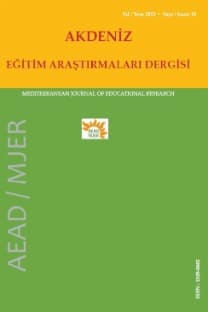A crash course to improve punctuation skills of undergraduate students
Lisans Öğrencilerinin İngiliz Dilinde Yazarken Noktalama İşaretleri Kullanımlarını Geliştirmesi Üzerine Bir Çalışma
___
Alamin, A., & Ahmed, S. (2012). Syntactical and Punctuation Errors: An Analysis of Technical Writing of University Students Science College, Taif University, KSA. English Language Teaching, 5(5), 2-8.Araman, B., & Wiggin, B. (1997). ESL reading: research and applications. TESL Reporter, 30(1), 4-6.
Ausloos, M. (2010). Punctuation effects in english and esperanto texts. Physica A, 2835-2840, doi:10.1016/j.physa.2010.02.038.
Bar-Aba, E. B. (2003). Punctuation marks: procedural and conceptual uses. Journal of Pragmatics, 35, 1031–1048.
Chen, X., Huang, B., & Ye, D. (2018). The role of punctuation in P2P lending: Evidence from China. Economic Modelling, 68, 634–643, DOI: dx.doi.org/10.1016/j.econmod.2017.05.007.
Daffern, T., Mackenzie, N. M., & Hemmings, B. (2017). Predictors of writing success: How important are spelling, grammar and punctuation? Australian Journal of Education, 61, 75-87.
Dowden, T., Pittaway, S., Yost, H., & McCarthy, R. (2013). Students’ perceptions of written feedback in teacher education: ideally feedback is a continuing two-way communication that encourages progress. Assessment & Evaluation in Higher Education, 38(3), 349-362 https://doi.org/10.1080/02602938.2011.632676.
Elkilic, G., Han, T., & Aydin, S. (2009). Punctuation and capitalization errors of Turkish EFL students in composition classes: An evidence of L1 interference. International Symposium on Sustainable Development, (pp. 279-284). Sarajevo.
Erel, S., & Bulut, D. (2007). Error treatment in L2 writing: A comparative study of direct and indirect coded feedback in Turkish EFL context. Sosyal Bilimler Enstitüsü Dergisi, 22(1), 397-415.
Ghabool, N., Mariadass, M. E., & Kashef, S. H. (2012). Investigating Malaysian ESL Students' Writing Problems on Conventions, Punctuation, and Language Use at Secondary School Level . Journal of Studies in Education, 2(3), 130-143.
Hirvela, A., Nussbaum, A., & Pierson, H. (2012). ESL students’ attitudes toward punctuation. System, 40, 11-23, DOI: 10.1016/j.system.2012.01.006.
Houghton, K. J., Upadhyay, S. S., & Klin, C. M. (2018). Punctuation in text messages may convey abruptness. Period. Computers in Human Behavior, 80, 112-121.
Hyland, K., & Anan, E. (2006). Teachers’ perceptions of error: The effects of first language and experience. System, 34, 509-519.
Kesmez, A. (2015). An analysis of the L1 interference erros of Turkish university students in their written produtions. International journal of soial science, 34, 395-402.
Kulig, A., Kwapien, J., Stanisz, T., & Drozdz, S. (2017). In narrative texts punctuation marks obey the same statistics as words. Information Sciences, 98-113.
Leki, I. (1991). The Preferences of ESL Students for Error Correction in College-Level Writing Classes. Foreign Langugage Annals, 203-2018.
Marton, F., & Shirley, B. (2013). Learning and awareness. Routledge.
McCourt, F. (2003). Foreword. In L. Truss, Eats Shoots & Leaves: The Zero Tolerance Approach to Punctuation (pp. xii-xiv). New York: Gotham Books.
McDermott, J. (2016). Punctuation for Now. Springer.
Ngangbam, H. (2016). An analysis of syntactic erros committed by students of English language class in the written composition of Mutah University: a case study. European Journal of English Language, Linguistics and Literature, 3(1), 1-13.
Rula, L. D. (2005). EFL University Students’ Preferences for Error Correction and Teacher Feedback on Writing. TESL Reporter, 38(1), 27-51.
Sawyer, R. (2018, 06 01). Teaching Punctuation with Literature. Retrieved 07 11, 2019, from https://digitalcommons.wou.edu/cgi/viewcontent.cgi?article=1136&context=aes
Thewissen, J. (2013). Capturing L2 Accuracy Developmental Patterns: Insights From an Error-Tagged EFL Learner Corpus. The Modern Language Journal, (97)1, 77-101 DOI: 10.1 lll/j.1540-4781.2012.01.
Trask, R. L. (2019). The Penguin Guide to Punctuation. Penguin.
- ISSN: 1309-0682
- Yayın Aralığı: 4
- Başlangıç: 2008
- Yayıncı: Tayfun Taşbilek
Öğretmen Adaylarının Uzamsal Yetenek ve Uzamsal Yetenek Öz-Değerlendirmeleri Arasındaki İlişki
Değer Aktarma Yaklaşımına Göre Hayat Bilgisi Dersinde Sorumluluk Eğitimi
İrem NAMLI ALTINTAŞ, Hüseyin MERTOL, Ömer ÇELİKKOL
Müzik Öğretmeni Adaylarının Eğitim Teknolojisine Yönelik Özyeterlilik ve Tutumları
Müzik Öğretmeni Adaylarının Çalgı Metodlarından Beklentileri
Lise Öğrenci ve Öğretmenlerinin Kahoot Kullanımına İlişkin Görüşleri
ÖĞRETMEN ADAYLARININ FEN VE MATEMATIĞE YÖNELIK ALGILARININ BELIRLENMESI: METAFOR ÇALIŞMASI
